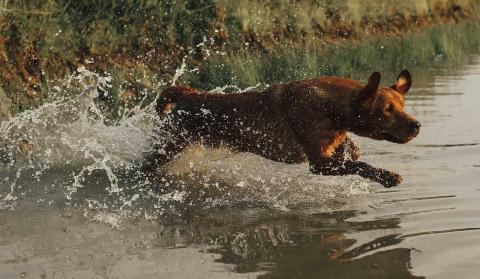Andrew Walters | Originally published in GameKeepers: Farming for Wildlife Magazine
“The sweetest hunts are stolen. To steal a hunt, either go far into the wilderness where no one else has been, or else find some undiscovered place under everybody’s nose.” – Aldo Leopold, “A Sand County Almanac”
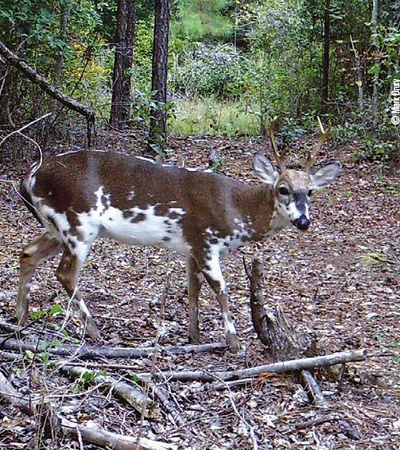
including albino twins and this piebald buck.
The sun crested the horizon and I could feel its warm rays soaking into my clothing, thawing out my body which seemed to be frozen to the core. The bright rays bounced off the timber revealing crimson and scarlet leaves barely clinging to the limbs that bound them. It wouldn’t be long before the deer would begin moving to feed on fallen acorns littering the frost-covered forest floor.
One may have thought I was hunting in some remote wilderness, but not long after sunrise I could hear voices, cars passing nearby, and dogs barking as the suburban neighborhood began to wake. What seemed like an unpressured rural property was actually a densely populated suburban neighborhood. Even more amazing than the fact a hunter would chose this area was the quality of bucks that inhabited the forested parcel. Many people hear stories about huge suburban bucks, but what isn’t understood is they can be managed similarly to other types of settings.
Urban Deer Hunting Obstacles
There are many challenges to hunting populated areas within, or just outside of, city limits; such as archery only seasons, divided topography, close and nosey neighbors and mandatory bow hunting safety courses. Gaining access to hunt is one of the largest obstacles to overcome. Since we’re exploring a few urban deer management practices from the position of being a “guest on a property,” we must always remember to respect the land, the animals and the property owner. If you don’t own the property it’s not wise to stick a lot of money into improvements since your future access to the land is unknown. With that in mind, there are a few simple, inexpensive things we can do to benefit the whitetails and our hunting.
One must remember that when asking permission they are considered a spokesperson and an ambassador of “the entire hunting community.” The people you ask permission from may not have met a hunter before or may not agree with hunting in general. Making a great first impression is imperative, so always be respectful and realize that you will most likely be rejected more than you hear “yes.”
There is little chance of having the acreage necessary or the ability to have huge food plots strategically laid out on these properties. Trail cameras have a greater chance of “magically disappearing” than they do in rural areas and leaving stands without first placing a lock on them is a daring move. The timber present is what you will have to deal with. Unless you own the parcel, there is little chance of TSI (timber stand improvement), hinge cutting to create bedding areas and browse, prescribed burns, or retention cuts on mature trees to open up canopies and to boost mast production.
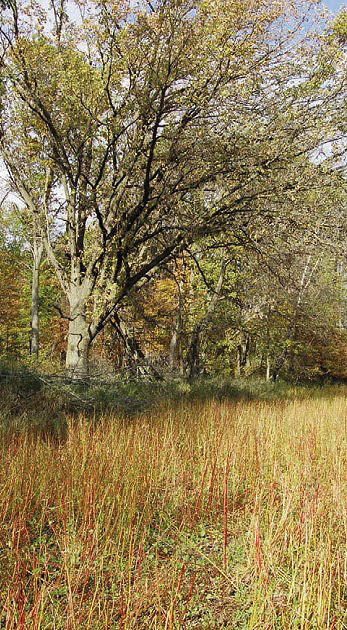
suburban hunting plot. Here you see Hot Spot mixed with
Perfect Plot. The red and brown buckwheat stalks in Hot
Spot have been browsed heavily and now the green
brassicas and clovers underneath are beginning to get hit
hard.
Aside from these obstacles, suburban areas offer a great chance to implement some unique management practices if one is willing to take on the challenges.
Your Average Ambush...Not
Herd management, or “selective harvest,” is one area we can have a huge influence over by just exercising our “trigger finger.” We can impact the number of animals, the size of the bucks and how successful our hunting will be whether we’re hunting rural areas, urban sites or even public ground.
Due to the number of antlerless deer that will most likely need to be harvested, your ambush locations are just as important as any other type of management tool. In most cases it is best to have many ambush sites set up to play various situations or weather conditions. This allows you to harvest your doe quotas and still have fresh stand sites ready to pursue a mature buck or two.
Minimizing the disturbances near your setups will allow them to be productive all season. On one larger woodlot, I have “shooting stands” set up specifically to harvest does, then “buck blinds” set up that I only use to attempt to harvest my target bucks. This allows the taking of does without educating the surviving deer to “that spot” being “danger” because of the disturbance. While stand locations are not the main focus they are important when managing herd dynamics for urban deer hunting.
The View from Above
Aerial photos, satellite images and topographical maps allow a better interpretation of the land and may assist you when deciding how to manage a particular area. If a dense finger of trees is connecting a bedding area to a feeding area, you have a great travel corridor and should plan your stand sites accordingly. Many woodlots in neighborhoods have creeks running through them or occasionally an ephemeral pool that could be used as a water source. The “view from above” can save you a lot of leg-work and unnecessary pressure on the spot.
Conifer trees are easy to decipher from hardwood trees, especially if the image was taken during the winter months. Many maps are clear enough to interpret individual trees due to their crown size and can assist you in picking out a general area to choose before even setting foot afield.
In one instance there was a creek running through a community and it was backed up because of a beaver dam. Due to the size of the dam I figured it would be used as a means of travel, much like a short cut. An hour before dark on a cool November afternoon a mature eight pointer came slipping through the cattails. The shot was quick and so was the blood trail. It was obvious I should hunt the dam after studying an aerial image.
A Picture is Worth the Neighbor’s Words
Trail cameras are invaluable at providing information for urban deer management purposes and will assist you in determining the age structure, density and buck to doe ratio of your herd. Some recommend one camera per 30-50 acres, but if your acreage is smaller I would set up as many as workable so long as the pictures reveal the deer are not spooked by the constant surveillance.
Mineral sites like BioLogic’s BioRock or Full Potential (where legal) are a great way to set up a potential list of shooter bucks while providing extra nutrition to your herd. Trail camera pictures will assist you in aging many of your bucks and help you to make the herd management decisions necessary for your area.
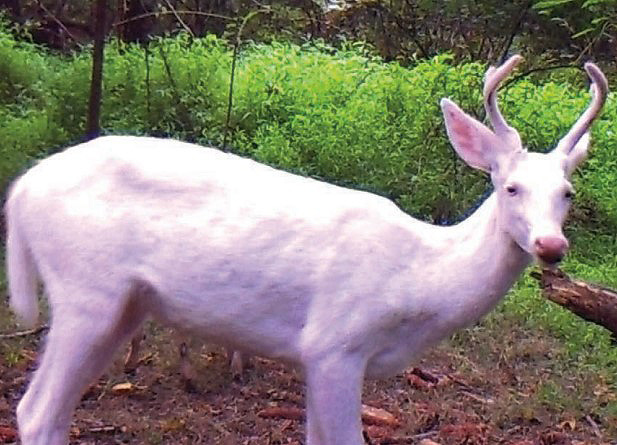
Trail cameras aren’t the only means of monitoring your land. Another valuable resource is the neighborhood residents. The whitetails that inhabit these urban wooded areas aren’t pushovers by any means; however, they do seem to be more tolerant of humans when compared to their rural relatives.
If there is an exceptional buck roaming around, chances are he has been spotted by one of the property’s neighbors. This was the case in an area I hunted while attending NC State University. The particular area was known to have an unusual amount of albino deer within the herd. There were also a few bucks that grew to be quite old and made more than a few appearances. I learned just as much by talking to a retired man who spent many hours on his porch passing the time as I could have by looking at hundreds of trail camera photos.
In the era of trail camera technology, we sometimes forget the art of gathering information from others and just talking to the local residents can be just as valuable, if not more so. The key is to utilize “all available resources” in order to learn about urban deer management.
Not All Timber is Created Equal
Some of the areas I hunt are full of mast producing trees such as white oaks and persimmon trees, while others are packed full of yellow-poplars and maple trees, providing only security cover, but little food. The forested cover will help to determine what types of management decisions you should make.
On properties where there is little to no mast producing trees or high-quality shrub-layer forage, I have found that a small “hunting plot” of BioLogic’s Hot Spot can be very attractive to whitetails. This can be done by simply using a backpack sprayer and herbicide to eliminate the existing vegetation, a handheld rake to disturb the soil, a handheld broadcaster and a bag of fertilizer. Killing the vegetation a week or two in advance and using a rake to ensure good seed to soil contact after broadcasting are two key points with a “no-till” plot like this.
Using a saw to clear saplings will allow sunlight to penetrate to the forest floor and stimulate the germination and development of many native plants in addition to food plot plantings. Mixing natural vegetation into or around the plot will create a feathered edge making the small plot more appealing by blending in with the natural surroundings. Deer are more comfortable when approaching and feeding in irregularly shaped plots with adjacent security cover.
If you are lucky enough to gain access to land with hard or soft mast available, you can release these trees to allow them to gain full benefit of all the existing sun, moisture and soil nutrients for the spot. Eliminating the shrubs and competing vegetation around a crop-tree will allow the tree to absorb more nutrients and be more productive. While this isn’t always the most effective procedure, it can be conducted where girdling trees isn’t an option.
Fertilizing mast trees during the spring will also help production. This may be just what your area needs to become a hotspot when the time is right. A simple 5-10-15 fertilizer will work great for hard or soft mast trees.
No Excuses
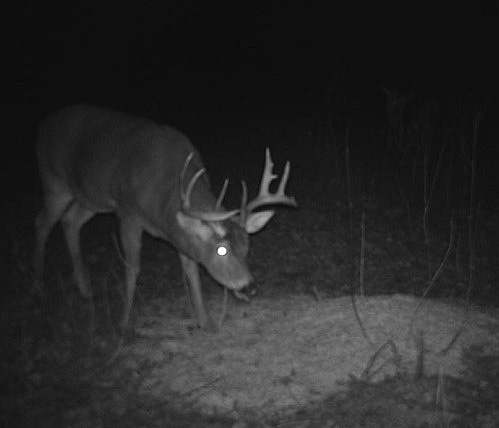
commonly visit the site at night so it really isn’t much help in harvesting the
animal; however, baiting can help provide information vital to your urban deer
management plan.
Once the season has arrived it’s time to “get down to brass tacks.” “Herd management” can be accomplished anywhere you hunt and can make a huge difference even if you aren’t planting food plots or enhancing natural habitat. It may take a couple seasons of intense doe management to meet some goals, but it is necessary in most areas if sustained quality hunting is your goal.
If you are passing opportunities to harvest does in hopes you will get a shot at one “shooter buck,” you need to reassess your “management execution.” Just like the “big woods” or farm regions, quality bucks can’t be produced overnight. The key to reducing the number of antlerless deer is to hunt smart, not hard. Herd management is crucial when managing properties for whitetails and it doesn’t change because of their suburban location.
Between traffic collisions, dispersions, and natural causes, many deer may not make it to the following year. The cold hard truth that "deer die" is a tough pill to swallow for some. While this is the case with any area, the deer of suburbia are more prone to crossing highways, mainly because they live closer to roads and there are many more of them. I have occasionally seen deer watch traffic pass before crossing, possibly adapting and learning how to survive better while living close to humans.
I find it interesting to learn their life-span before they die from non-hunting incidents. If you rarely notice deer over three years old, you may not choose to pass a buck that age. However, if you observe deer making it to four and five, that three year old should probably be passed. Either way, there is no harm in letting a buck mature another year. It sounds cliché, but the old adage “let him go so he can grow” has never been more applicable than with suburban deer management. Age is the best way to see an increase in antler size and skeletal growth and passing an opportunity to sling an arrow before his prime is the only way to see his potential.
The survival rate of these deer may surprise you. I recorded trail camera data of twin albino bucks a year ago. This year I pulled a card on one of my cameras and found photos of one of the albino twins and saw the second one while scouting. Who would have thought that two white fawns could not only survive, but thrive in an area with a high predator density and right by one of the busiest highways in the state?
To Each His Own
Where legal, baiting or feeding can be a controversial issue, so I’m not going to shake the proverbial “hornets’ nest” by choosing a side. That being said, I will point out some pros and cons of the use of minerals, corn or other types of bait. Studies have shown through tracking GPS collared deer that bait sites are used largely at night, especially by bucks.
As you can guess, this doesn’t benefit us as hunters. On the other hand, baiting to gather trail camera information is great for learning the necessary dynamics to make management decisions.
Many people use bait when taking a new hunter to the woods due to the fact that it increases the odds of spotting wildlife in most areas. This can help keep a new, young hunter interested in the hunt.
Keep in mind, temporarily baiting to harvest deer and a supplemental feeding program are two different management strategies. The decision of whether or not to bait or feed is yours depending on your perspective, just be sure to check all local and state game regulations if you decide to do so.
Not only can a suburban deer herd be managed, it can be done easier than most expect and the outcomes can be amazing. The next time you pass a parcel of woods meandering through a suburban neighborhood, stop and think about the opportunities. Don’t let the location of a particular piece of land or the lack of acreage define your possibilities. Suburban deer are adaptable, resilient, and crafty and you must be the same in order to capitalize on the location and lack of hunting pressure.
Andrew Walters is a senior in Wildlife and Fisheries Science at North Carolina State University and the NCSU QDMA President.














